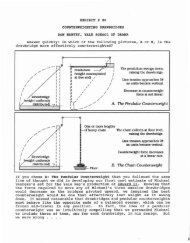Cable Tester - Designs by Patrick Immel
Cable Tester - Designs by Patrick Immel
Cable Tester - Designs by Patrick Immel
Create successful ePaper yourself
Turn your PDF publications into a flip-book with our unique Google optimized e-Paper software.
Thank you for taking time to read this “classic” Technical Source Guide! Because it has been published a relatively long time ago,addresses (physical & web) and any phone numbers, might not be current!TECHNICAL SOURCE GUIDECABLE TESTERBy Thomas J. BlalockThe home-brew cable tester described in this article has two advantages over thecommercially available ones: it costs less (if you count only the cost of materials), and it givesyou the ability to do a pseudo load test on a cable, something not possible with an LED-basedcable tester.Construction of this cable tester is quite simple. Three octagonal junction boxes are arrangedin a row, connected with 1/2" conduit. As indicated in Figures 2 and 3, the wires are arrangedso that lamp A is connected to Hot (black wire) and Neutral (white wire), Lamp B is connectedto Neutral and Ground (green wire), and lamp C is connected to Ground and Hot. A length of12 gauge three-wire SO cable, terminated with a standard three-pin stage plug, is connectedto the device as shown in Figure 2. The 120 volt power supply is wired with a normally closedpush-button to lift (disconnect) the Ground.To use the tester, plug one end of your cable into the power supply and the other end into thetester. Three equal-wattage lamps, typically 150W, must be used to be able to accurately readthe cable condition based on the following table:Lamp A Lamp B Lamp C <strong>Cable</strong> Conditionbright out bright OKbright bright out Hot and Neutral reversedout bright bright Hot and Ground Reverseddim dim bright Neutral Openbright dim dim Ground Opendim bright dim Hot on Neutral with Hot Open, orHot on Ground with Hot Open- 1 - Technical Source Guide #24 - CABLE TESTER
Thank you for taking time to read this “classic” Technical Source Guide! Because it has been published a relatively long time ago,addresses (physical & web) and any phone numbers, might not be current!TECHNICAL SOURCE GUIDENormally, it is difficult to determine whether Neutral and Ground are reversed, since theNeutral is always supposed to be grounded at the Service Entrance. In our tester, using the“ground lift" switch installed at the supply end of the cable will produce the following results:Lamp A Lamp B Lamp C <strong>Cable</strong> Conditionbright dim dim OKdim dim bright Neutral and Ground ReversedOur cable tester, using 150W lamps, will typically pull one or two amps through the cablerather than the very tiny amount of current drawn when using LED or neon testers. This canshow connection problems because the brightness of the lamps will be affected due to theresistance drop in bad connections. To effectively load test a cable, use three 1200W lampsinstead of the normal 150W ones. It is important to note that this lamping-up, to create apseudo load tester, will only test load on the Hot line.The cable tester described in this article is inexpensive and simple enough for just about anytheatre technician to build. It has worked well in actual use, and if properly constructed, usingcode- appropriate materials and safe wiring practices, this circuit tester will be a valuableaddition to the tools of any theatre.FIGURE #1- 2 - Technical Source Guide #24 - CABLE TESTER
Thank you for taking time to read this “classic” Technical Source Guide! Because it has been published a relatively long time ago,addresses (physical & web) and any phone numbers, might not be current!TECHNICAL SOURCE GUIDEFIGURE #2 CONSTRUCTION DETAILS- 3 - Technical Source Guide #24 - CABLE TESTER
Thank you for taking time to read this “classic” Technical Source Guide! Because it has been published a relatively long time ago,addresses (physical & web) and any phone numbers, might not be current!TECHNICAL SOURCE GUIDEFIGURE #3 WIRING SCHEMATICThank you for taking time to read this “classic” Technical Source Guide! Because it has been published a relatively long timeago, addresses (physical & web) and any phone numbers, might not be current!Technical Source Guide #24 – CABLE TESTER• A project of the USITT Technical Production CommissionDisclaimer: the publisher does notassume any liabilities resulting from theuse of the information contained in thisdocument. Neither Sightlines norUSITT endorses any products presented.- 4 - Technical Source Guide #24 - CABLE TESTER
















